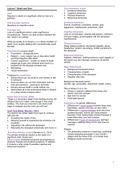Notizen
Summary of all Lectures of Loss and Psychotrauma UU
- Kurs
- Hochschule
This document is a summary of all 8 lectures given for the course loss and psychotrauma . Images are included to clarify certain information. The first pages are representative of the rest of the document
[ Mehr anzeigen ]




